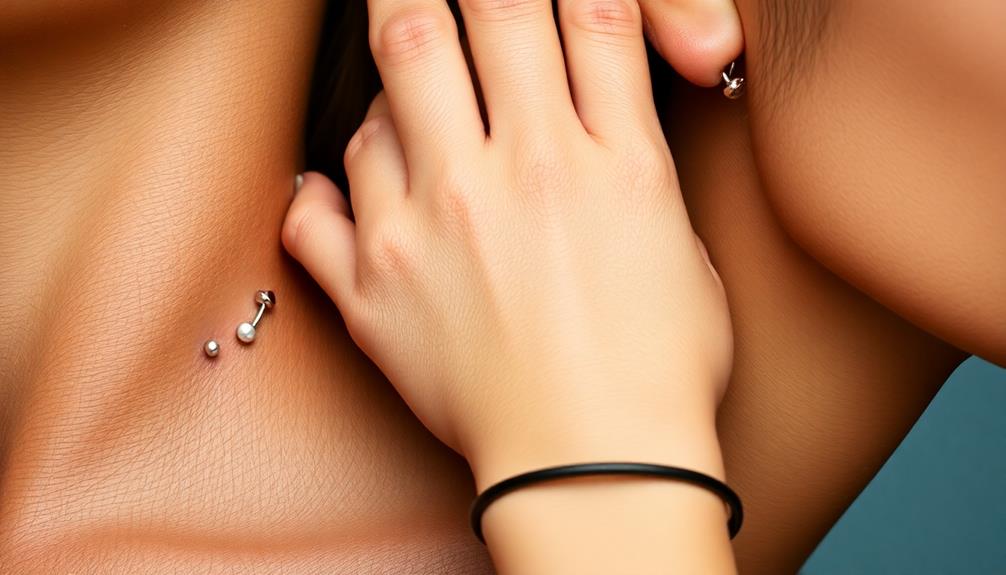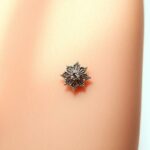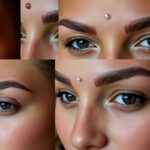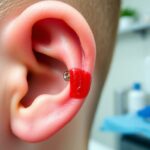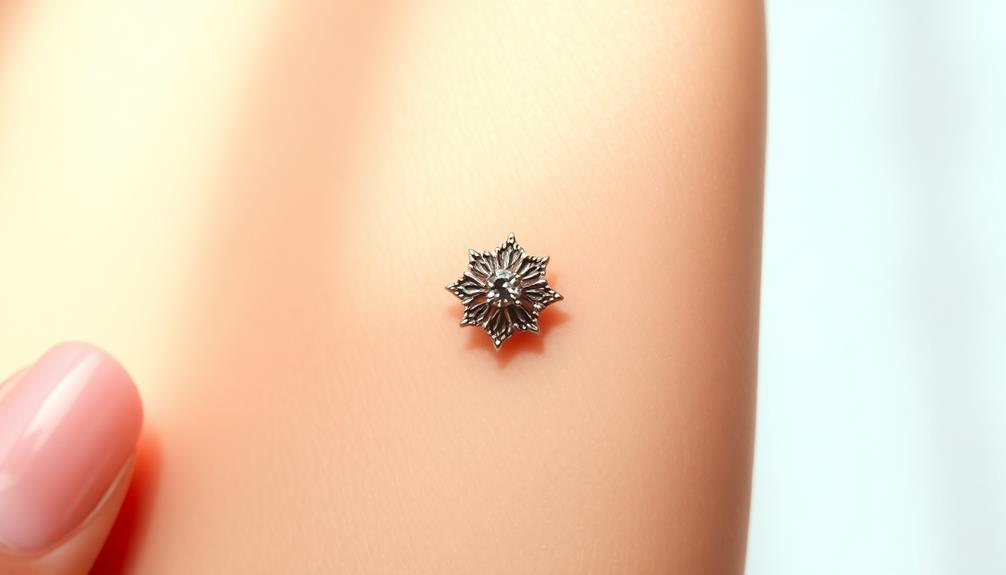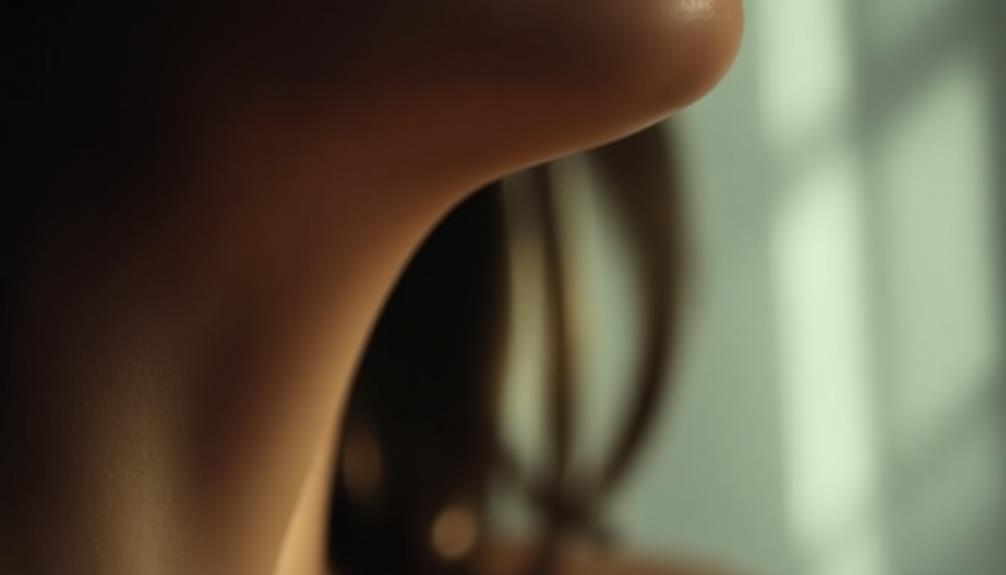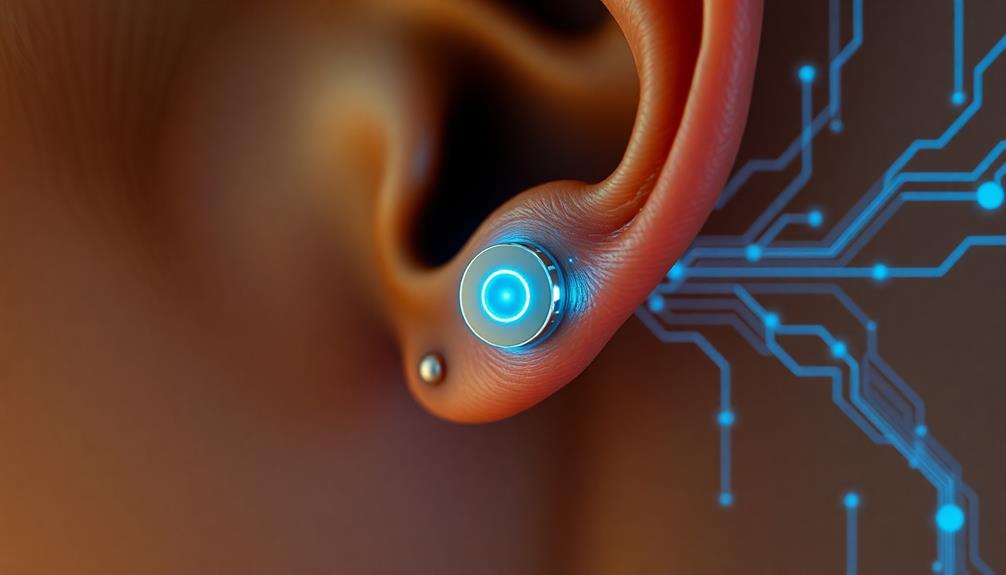If you're considering dermal piercings, it's vital to choose the right placement and understand rejection rates. High-friction areas, like hips and wrists, can have rejection rates up to 50%. Instead, opt for flatter, low-movement spots like the collarbone, cheekbones, or nape of the neck to enhance healing and retention. The depth of the anchor and jewelry gauge also play a key role in stability. Proper aftercare is essential to minimize risks. You'll find that informed choices regarding placement and care can greatly improve your dermal piercing experience and longevity. There's plenty more to explore about this fascinating topic!
Key Takeaways
- Dermal piercings have a rejection rate of approximately 50%, largely influenced by placement and body movement during healing.
- Ideal placement areas for dermal piercings include cheekbones, collarbones, and the nape of the neck for better retention.
- High-friction areas like hips and wrists should be avoided to minimize the risk of rejection and irritation.
- Proper aftercare, including daily cleaning and avoiding tight clothing, is crucial for reducing rejection rates and promoting healing.
- Heavier gauge jewelry and deeper anchor placement enhance stability, helping to prevent migration and rejection.
Understanding Dermal Piercings
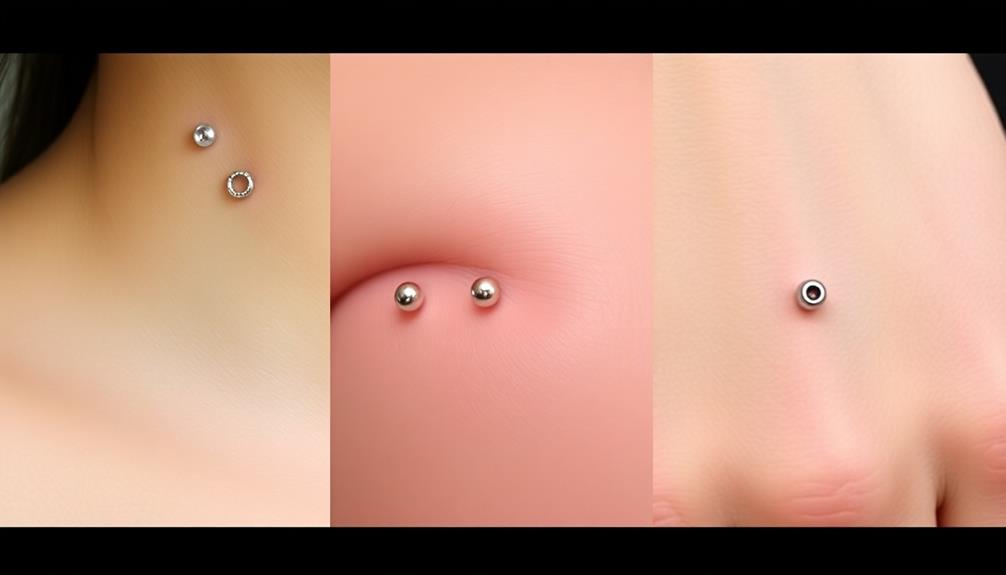
Dermal piercings, often referred to as microdermal piercings, offer a unique way to express your style with their single entry point and anchored design. These piercings consist of an anchor placed beneath the skin, allowing decorative tops to sit flush against the surface.
However, understanding their characteristics is vital for success. The healing time for dermal piercings typically ranges from 1 to 3 months. During this period, following proper aftercare instructions is essential to minimize complications and enhance healing.
Keep in mind that dermal piercings have a rejection rate of approximately 50%, influenced by factors such as the ideal placement and body movement. To improve longevity and reduce rejection risk, avoid high-friction areas or those subject to constant movement like the hips or wrists.
Instead, consider flat areas of the body, such as the cheekbones, collar bones, or lower back. These locations tend to reduce the risk of snagging and irritation, allowing for a more successful piercing experience.
Popular Placement Areas
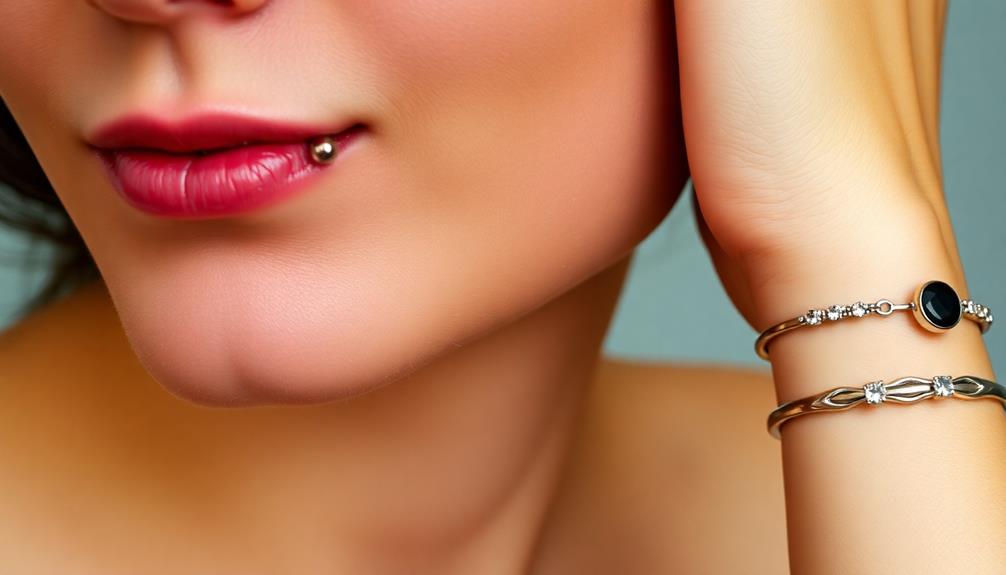
When it comes to choosing placement for your dermal piercings, several popular areas stand out due to their aesthetic appeal and lower risk of rejection. Selecting the right spot can greatly influence your healing process and the overall success of your body modification.
Here are three top placement areas:
- Cheekbones: This area offers a striking visual effect while typically experiencing lower friction, enhancing retention rates.
- Collarbones: These provide a unique canvas for jewelry choice, making them a favored spot for aesthetic options.
- Nape of the Neck: With minimal movement and friction, this location promotes better healing and retention rates.
While areas like the hips and wrists are also popular, they may have higher rejection rates due to increased movement.
It's essential to reflect on how your individual healing responses might affect the longevity of your dermal piercings. By choosing placements with less friction, you can enjoy your piercings longer and showcase the unique designs that dermal piercings offer.
Always remember to prioritize comfort and aesthetics when making your decision!
Rejection Rates Explained
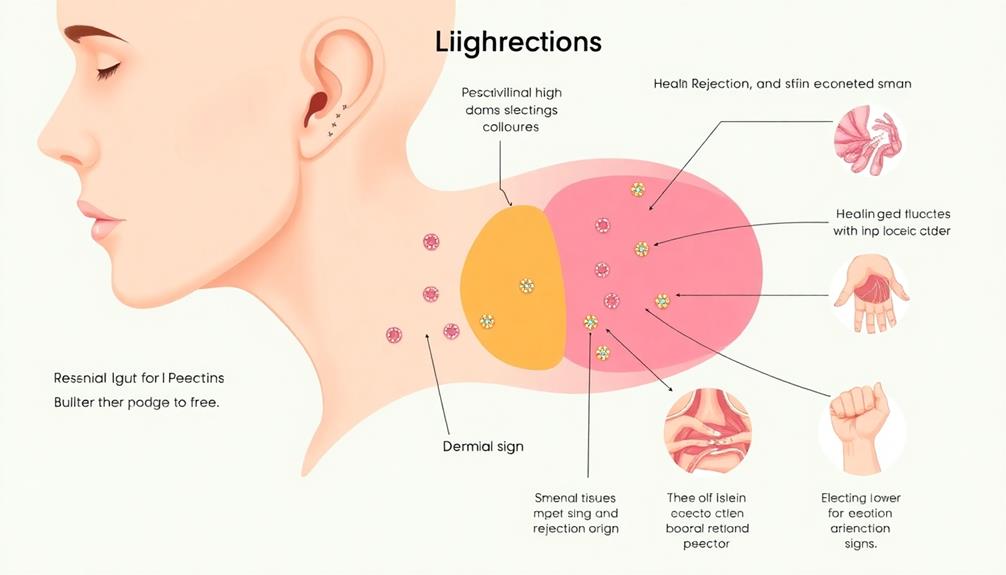
When considering dermal piercings, understanding rejection rates is essential for your success.
Common causes of rejection include friction from movement and improper anchor depth, which can lead to complications.
Common Causes of Rejection
Rejection of dermal piercings can be a frustrating experience for many individuals. Understanding the common causes can help you minimize the risk. Here are three primary factors that contribute to rejection:
- Placement: Areas of the body that experience frequent friction or movement, like hips or fingers, are more prone to rejection. The body often perceives the jewelry as a foreign object, leading to discomfort and eventual expulsion.
- Shallow Insertion: If the anchors are inserted too shallowly, the body can easily push them out during the healing process. A deeper placement generally offers better stability and reduces the risk of rejection.
- Jewelry Choice: Using heavier gauge jewelry can enhance stability, especially in less fleshy areas. Properly chosen jewelry minimizes movement and irritation, which can lead to a successful healing experience.
Additionally, proper aftercare is essential. Taking steps to minimize irritation from clothing or accessories during the healing phase can greatly lower rejection rates.
Preventing Rejection Risks
To effectively prevent rejection risks for your dermal piercings, it's important to understand the factors that contribute to their success. Rejection rates can soar as high as 50%, especially in areas prone to friction and movement, like the hips or wrists.
Aim for placement options that minimize these issues, such as the collarbones or lower back.
The depth of your anchor placement is significant; anchors positioned too shallow can easily migrate or be rejected by your body.
Using heavier gauge jewelry is another smart choice, as thicker pieces are less likely to be pushed out during the natural healing processes.
Proper aftercare is crucial for ensuring stability and longevity. Regularly clean your dermal piercings and avoid tight clothing that can irritate the area.
Be vigilant for infection signs, such as redness or unusual discharge, as these can increase rejection risks.
Factors Affecting Rejection
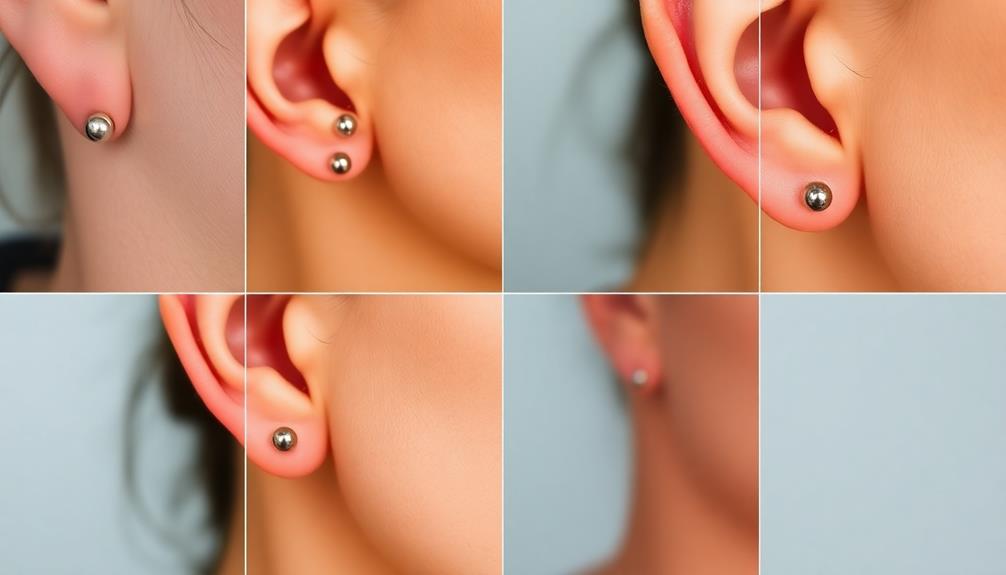
Several factors can considerably influence the rejection rate of dermal piercings. The body's natural reaction to foreign objects can lead to rejection, which may be as high as 50%. Understanding these factors helps you minimize risks.
- Jewelry Choice: The gauge and material of your jewelry matter. Heavier gauge jewelry generally provides better anchoring, reducing the likelihood of rejection.
- Skin Type: Your skin's thickness plays a significant role. Thinner skin may not adequately support the dermal anchor, increasing rejection chances.
- Friction and Movement: Areas with constant friction, like the hips or wrists, can irritate the piercing and disrupt the healing process, leading to a higher rejection rate.
To enhance your chances of success, pay attention to these factors. Remember that proper aftercare is also essential in minimizing rejection.
Avoid tight clothing around the piercing and keep the area clean. By being mindful of jewelry choice, skin type, and the effects of friction and body movement, you can better navigate the challenges associated with dermal piercings and improve your overall experience.
Aftercare and Healing
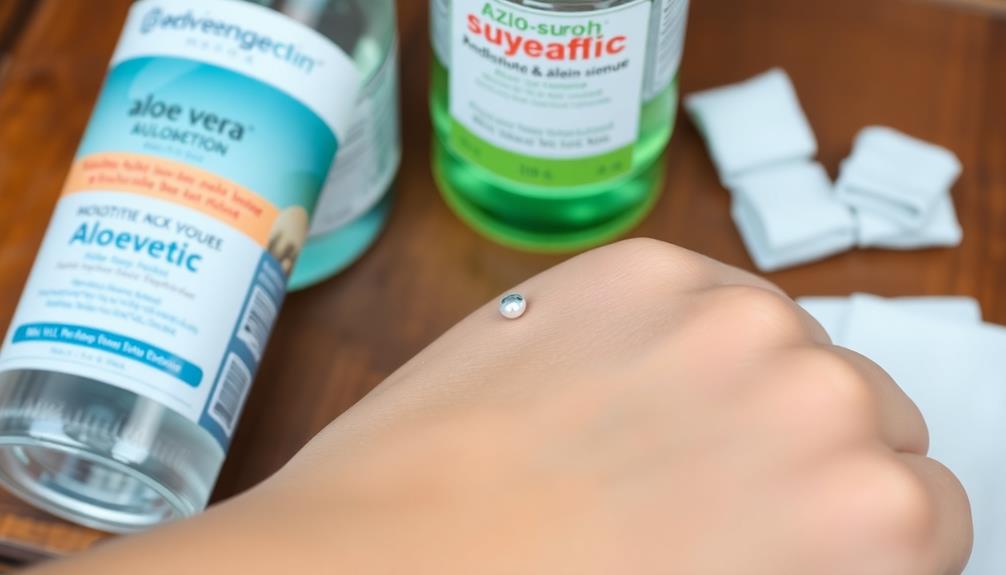
Aftercare is essential for the successful healing of dermal piercings. You'll need to commit to daily cleaning with saline or sea salt solutions to promote healing and prevent infection.
Avoid moisture and submersion in water, as these can hinder your healing time, which typically ranges from 1 to 3 months. Keep an eye out for crusting and minor swelling—these are normal, but watch for signs of infection like severe pain or unusual discharge.
It's imperative to avoid tight clothing and high-energy activities during the healing process. Friction and irritation can markedly raise rejection rates, jeopardizing your piercing's longevity.
Proper care is essential; consistent aftercare not only supports healing but also minimizes the risk of rejection or migration.
Jewelry Options for Dermals
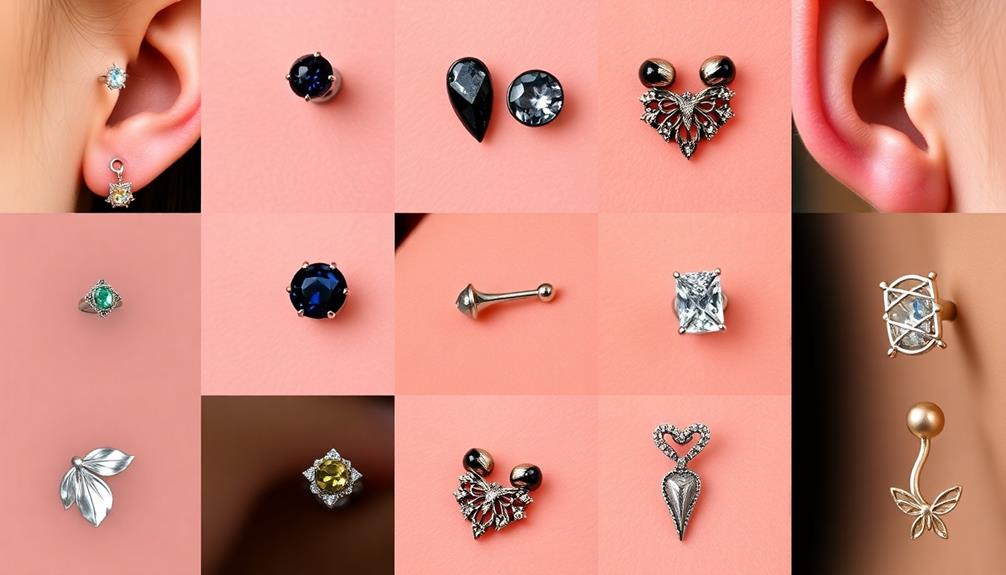
When choosing jewelry for dermal piercings, you'll want to explore various options that cater to both comfort and style. The right jewelry not only enhances your look but also guarantees a good fit and stability.
Here are three popular options to take into account:
- Dermal Anchors: These have flat or rounded bases secured beneath the skin, providing a solid foundation for your jewelry.
- Decorative Tops: After healing, you can switch out these tops for new looks. Options include gems and unique shapes, allowing for personalization.
- Non-Removable Jewelry: If you prefer a permanent aesthetic, this jewelry features a pointed-end base, eliminating the need for interchangeable tops.
Verify that whatever you choose is compatible with your anchor threading size. Consult with an experienced piercer to confirm that your jewelry options align with your placement options and body type.
Stainless steel is a popular choice because of its durability and hypoallergenic properties. Remember, proper sizing is essential; longer anchor bases support larger decorative tops, providing both stability and visual appeal.
Risks and Complications
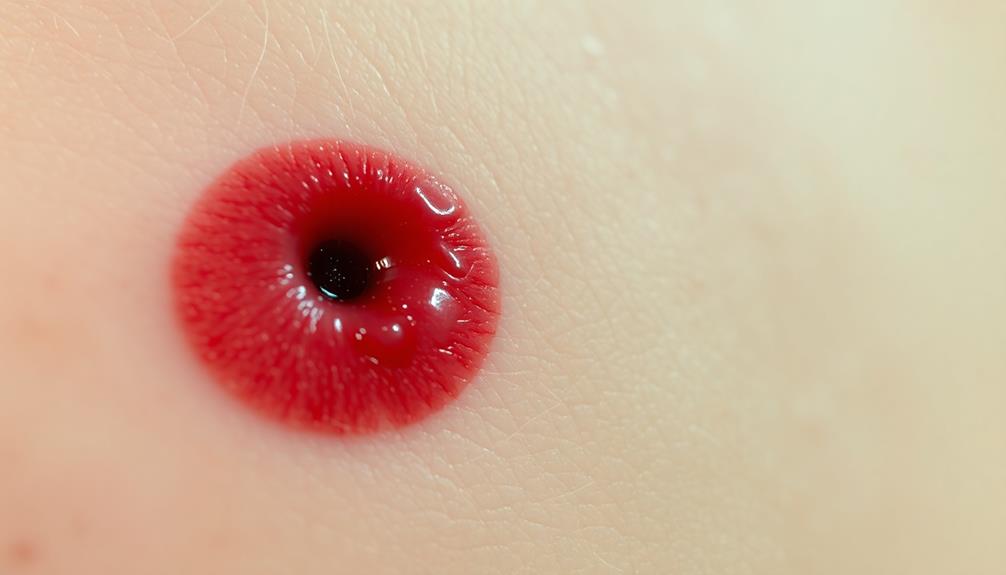
When considering dermal piercings, you should be aware of the risks of infection and displacement.
Rejection and migration can occur, especially if the piercing is placed in high-movement areas.
It's vital to follow proper aftercare to minimize these complications and guarantee your piercing heals well.
Infection and Displacement Risks
Although dermal piercings can enhance your style, they come with significant risks of infection and displacement that you need to be aware of. Understanding these risks can help you maintain your piercing and avoid complications. Here are three key points to take into account:
- Signs of Infection: You should watch for severe pain, swelling, and discharge. If you notice these symptoms, seek immediate attention to prevent further issues.
- Displacement and Rejection: The body may react negatively to foreign objects, leading to jewelry displacement or even rejection. Proper depth during insertion is vital, as is minimizing movement and friction in the area.
- Hypergranulation: If you see red bumps around your piercing, this could indicate irritation or pressure. You may need a jewelry adjustment or replacement to alleviate this issue.
To minimize these risks, proper aftercare is essential. Establish consistent cleaning routines to keep your piercing clean and reduce infection chances.
Pay close attention to any signs of irritation, and don't hesitate to consult a professional if you have concerns. Taking these steps can help guarantee your dermal piercing stays stylish and safe.
Rejection and Migration Issues
Rejection and migration are significant concerns for anyone considering dermal piercings. With a rejection rate hovering around 50%, nearly half of these piercings mightn't stay in place long-term.
The risk of migration increases dramatically if you choose placement in areas that experience high movement or friction, like your hips or wrists. Continuous snagging on clothing or accessories can lead to serious complications, including tissue damage and a higher chance of rejection.
To minimize these risks, proper placement and diligent aftercare are essential. Avoid tight clothing that could irritate the piercing during the healing process, as pressure can exacerbate the likelihood of migration.
Keep an eye on the surrounding tissue for signs of irritation or distress, which may indicate complications.
In high-movement areas, dermal piercings are more vulnerable, so think carefully about where you want to place your piercing.
Ultimately, being informed and proactive about your choice will help you enjoy your dermal piercing while minimizing the risks of rejection and migration.
Frequently Asked Questions
How Likely Is It for a Dermal Piercing to Reject?
Dermal piercings have about a 50% rejection rate. If you choose the wrong placement or don't follow aftercare, your piercing's likelihood of rejection increases considerably. Always consider your body's natural response to foreign objects.
What Piercings Have the Highest Rejection Rate?
Surface piercings usually have the highest rejection rates, often lasting less than nine months. When you choose placements on areas with constant movement or friction, like wrists or hips, rejection chances increase considerably.
What Piercings Are Most Commonly Rejected?
You'll find that surface piercings often face the highest rejection rates due to their unique structure. Areas with constant friction, like hips or fingers, considerably increase the likelihood of your piercings being pushed out.
How to Stop Your Dermal From Rejecting?
Imagine a delicate flower thriving in a garden. You'll keep your dermal piercing flourishing by choosing the right placement, using heavier jewelry, cleaning regularly, avoiding tight clothing, and monitoring for any signs of irritation.
Conclusion
In the world of body art, dermal piercings can feel like a modern twist on ancient adornments, enhancing your individuality. However, as with any artistic endeavor, you need to weigh the beauty against potential risks. By understanding placement options, rejection rates, and aftercare, you can navigate this journey with confidence. Embrace your inner rebel, but remember that every masterpiece requires care. So, are you ready to make your skin a canvas for expression?
Hi, my name is Danielle, and I’m an author for piercings-body.com. I have a passion for writing and love to share my knowledge on all things body piercing-related. I’m also a huge advocate for safe body modification practices and believe everyone should be able to make informed decisions about their bodies. When I’m not writing or blogging, I enjoy spending time with my family and friends, practicing yoga, and exploring new places.

